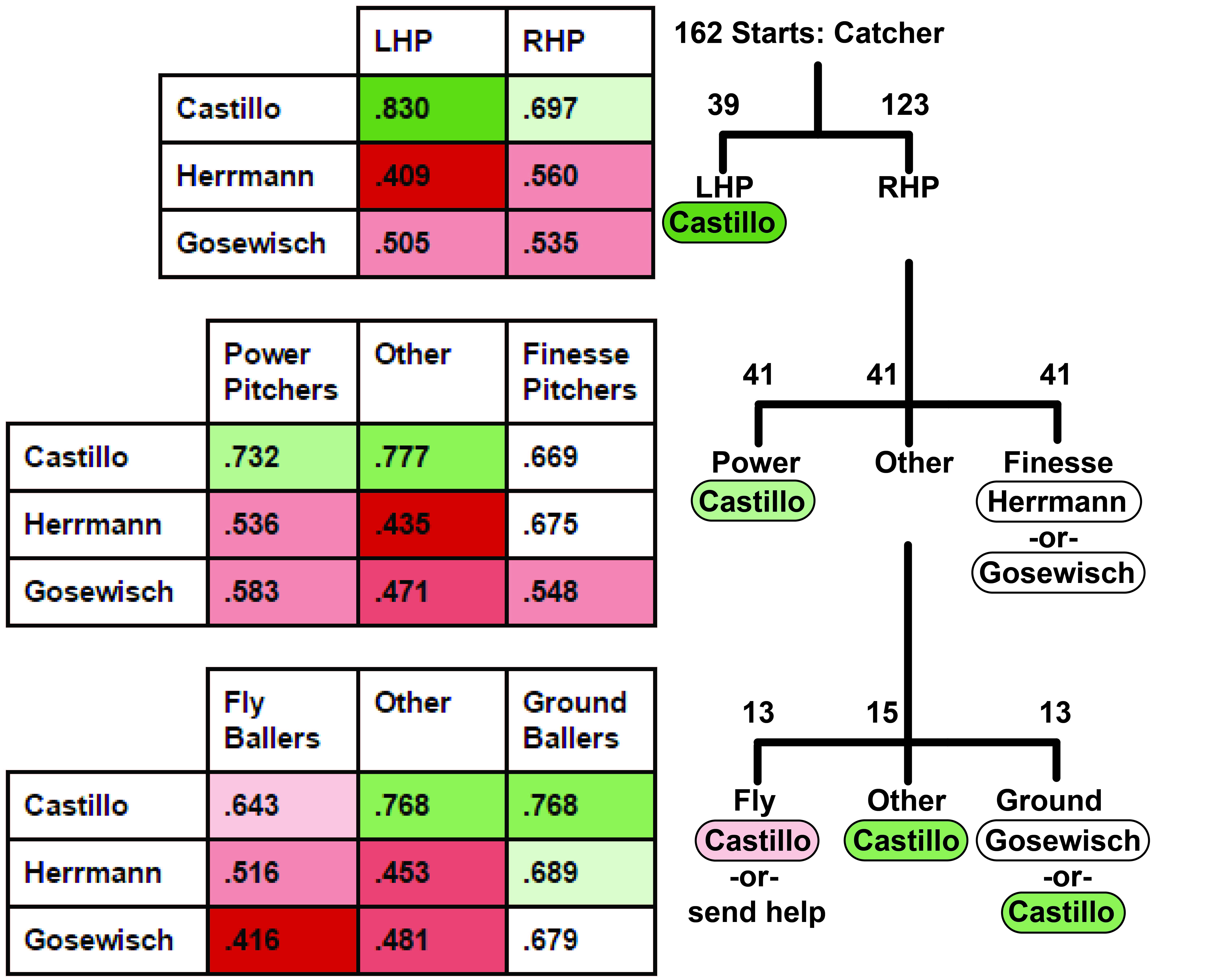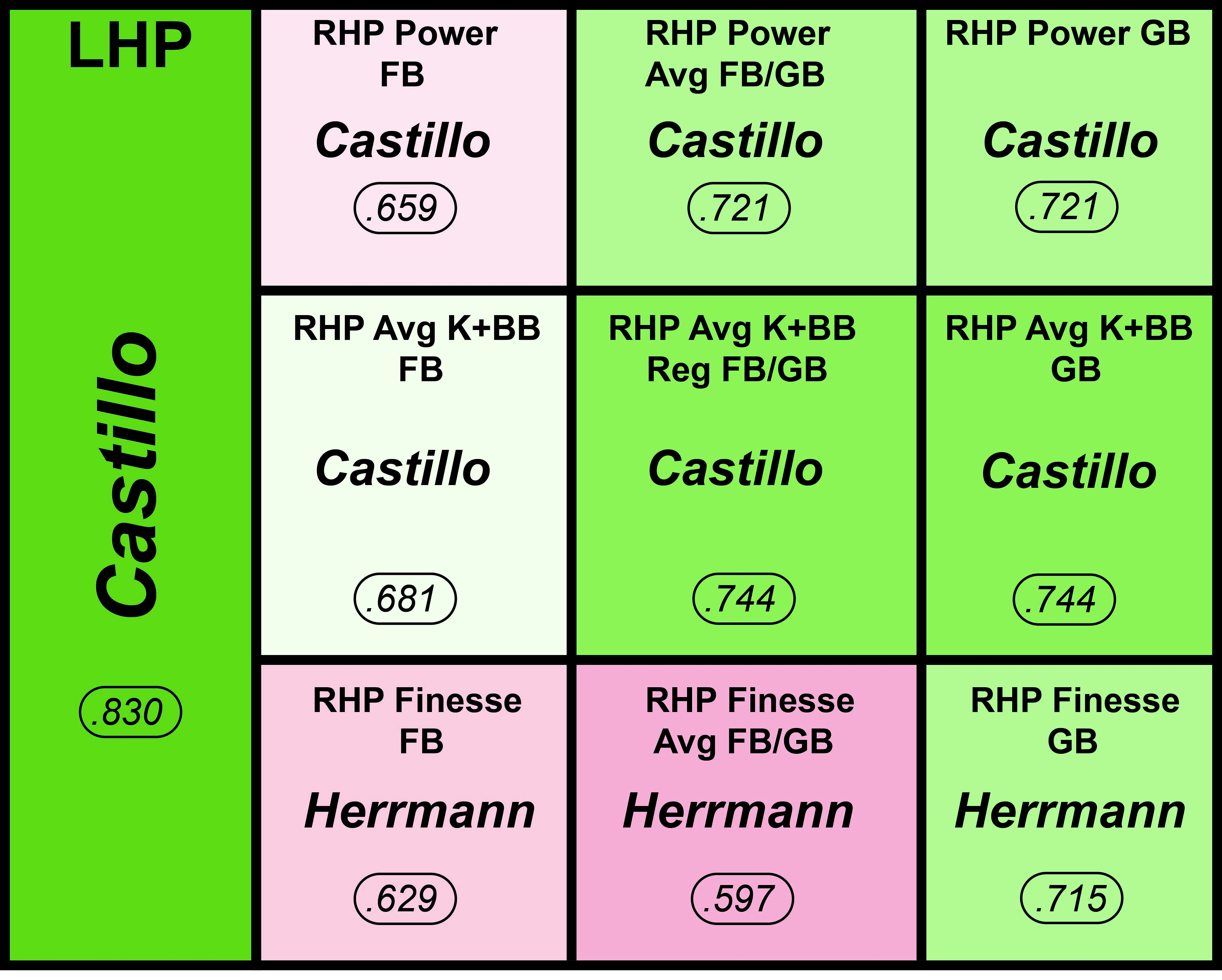Double Plus: D-backs Could Have Effective Catcher Platoon
Considering the D-backs’ struggles to build a pitching staff, it’s strange and probably unfortunate that the catchers the team has in camp right now are likely to rate poorly on the defensive side of the ball. At the plate, though, the story could be a lot different. Welington Castillo will undoubtedly lead the way, barring injury; his 17 home runs in 80 D-backs games last year was remarkable, and it powered a .496 slugging mark. Castillo probably won’t be that effective this year, especially since he’d hit just 29 bombs in his other 316 career games. PECOTA’s projection of a .249/.317/.418 slash line with 18 homers feels about right, and that would still be a solidly above average hitting performance.
You’ve probably heard that Castillo has been much better against southpaws in his career, with a bigger platoon split than average. That’s true. You’ve also probably heard that Chris Herrmann bats left-handed. That’s also true. You might have imagined that they’d make a decent pair at the plate, and you’d be right, again—but maybe for the wrong reason. The D-backs could have a decent hitting platoon on their hands at catcher, but that would probably need to be more nuanced than a simple left/right platoon.
Consider:
- As a right-handed hitter, Castillo would end up being the short side of a right/left platoon. Sure, one could aim him against lefties, so that all or most of his days off were against RHP; but if Castillo played 80% of games, chances are that more than half of them would come against RHP starters.
- Chris Herrmann has not been a good hitter. It’s true that he’s been better against RHP than LHP, as you’d expect of a lefty hitter—but his career numbers against lefties are still worse than Castillo’s career numbers against righties, as Jeff observed recently on The Pool Shot.
- Castillo might not need a platoon partner. Castillo had an above-average .808 OPS against lefties with the D-backs, which was actually a bit worse than his career split against lefties (.826 OPS). To the extent Castillo just had a breakout, it was from much better success against RHP (.815 OPS with the D-backs, .698 OPS career).
In other words, a right/left platoon really wouldn’t work and it really wouldn’t be helpful to the extent that it did work. That’s not, however, the only way the catchers can be aimed. As Jeff has explored before, pitchers’ launch angle tendencies can form the basis of a platoon; fly ball hitters tend to do better against ground ball pitchers than they do against fly ball pitchers, etc. And as a commenter pointed out Tuesday (thanks, anonymous), we can also trace how hitters fare against feast-or-famine pitchers with high combined K and BB rates (called “power pitchers”) versus pitchers with low combined K and BB rates who pitch to contact (called “finesse pitchers”).
Try this on for size, using career OPS numbers:
Seeing this should make you suspect a few things. One: I might be color blind, or I secretly like purple. Two: it can’t possibly be this simple.
Chances are you’re right about all of that. Playing around with it a little, I strongly suspect that there’s a lot of overlap between “power” and “fly and between “finesse” and “ground” — and RHP may be skewed in the direction of “finesse” and “ground.” Also, it’s definitely not clear which of these three things mean the most if they’re all in play. Still, it looks a whole hell of a lot like there isn’t much here that Herrmann can do that Tuffy Gosewisch can’t, especially when considering a sizable difference in defense.
As is nearly always the case: we can do better. So after assigning all of the LHP starts to Castillo, I simply acted like Power/Finesse and GB/FB were equally as important. Last year, catchers faced lefties about 22% of the time, and so for the RHP-specific starts, I also drained away 22% of each catcher’s platoon split in hopes of more accurate RHP-only numbers. Career defensive numbers suggest that Gosewisch would be worth zero to -5 runs on defense over a full season, with Herrmann more like -8 to -13, and Castillo -13 to -18—so I also resolved to give the better defender the nod if he were within 70 or 80 points of OPS of the next-worst defender ahead of him.
As it happens, this would put Castillo on track to start 120 games, and that’s a hell of a lot of green. If things worked out this way, D-backs catchers would have a .721 OPS, at least against opposing teams’ starters. There were a number of close calls, though. You could make a strong case for Gosewisch in the box on the far right, halfway up: his OPS worked out to a .582 there, and his defense makes that a close call with Castillo. Moreover, Finesse/GB and the Finesse box next to it with league average FB/GB did not give Herrmann heavy advantages over Gosewisch. There’s appeal to adding that bottom right green with Herrmann in the fold, but there’s also a lot of appeal to having him available for Finesse/GB — it’s a good place to rest Castillo, whose .626 OPS there is not better than Herrmann’s (and whose defense is a step worse).
I don’t want to pretend this is more accurate than it is, because it’s really not that accurate. It’s also too simple in a lot of ways, including pitching changes — Herrmann looks like the top guy to spell Castillo for starts, but if he’s asked to face a lefty late in the game, Herrmann’s two pink squares turn into the orangest pumpkins: a .478 OPS for Finesse/FB, and a ridiculous .446 OPS for the other box. It could really be helpful to carry three catchers, if possible, because despite many similarities, there are a lot of ways to mix and match Herrmann and Gosewisch. And, if the D-backs choose—they could get above-average offensive production out of catcher after all.
3 Responses to Double Plus: D-backs Could Have Effective Catcher Platoon
Leave a Reply Cancel reply
Recent Posts
@ryanpmorrison
 Best part of Peralta’s 108 mph fliner over the fence, IMHO: that he got that much leverage despite scooping it out… https://t.co/ivBrl76adF, Apr 08
Best part of Peralta’s 108 mph fliner over the fence, IMHO: that he got that much leverage despite scooping it out… https://t.co/ivBrl76adF, Apr 08 RT @OutfieldGrass24: If you're bored of watching Patrick Corbin get dudes out, you can check out my latest for @TheAthleticAZ. https://t.co/k1DymgY7zO, Apr 04
RT @OutfieldGrass24: If you're bored of watching Patrick Corbin get dudes out, you can check out my latest for @TheAthleticAZ. https://t.co/k1DymgY7zO, Apr 04 Of course, they may have overtaken the league lead for outs on the bases just now, also...
But in 2017, Arizona ha… https://t.co/38MBrr2D4b, Apr 04
Of course, they may have overtaken the league lead for outs on the bases just now, also...
But in 2017, Arizona ha… https://t.co/38MBrr2D4b, Apr 04 Prior to the games today, there had only been 5 steals of 3rd this season (and no CS) in the National League. The… https://t.co/gVVL84vPQ5, Apr 04
Prior to the games today, there had only been 5 steals of 3rd this season (and no CS) in the National League. The… https://t.co/gVVL84vPQ5, Apr 04 RT @OutfieldGrass24: Patrick Corbin has a WPA of .318 and it's only the fifth inning., Apr 04
RT @OutfieldGrass24: Patrick Corbin has a WPA of .318 and it's only the fifth inning., Apr 04
Powered by: Web Designers@outfieldgrass24
 This Suns matchup comes at a good time for my hometown Blazers #RipCity https://t.co/fQ45wdfQUk, 6 hours ago
This Suns matchup comes at a good time for my hometown Blazers #RipCity https://t.co/fQ45wdfQUk, 6 hours ago RT @ZHBuchanan: Our @Ken_Rosenthal spoke to Ken Kendrick about trading Paul Goldschmidt.
https://t.co/O5fHRlyBxD, 13 hours ago
RT @ZHBuchanan: Our @Ken_Rosenthal spoke to Ken Kendrick about trading Paul Goldschmidt.
https://t.co/O5fHRlyBxD, 13 hours ago RT @CardsNation247: We have a good show lined up for tonight. Leading off is our friend of the show @buffa82 followed by Jeff Wiser… https://t.co/eltZC0uvyg, 13 hours ago
RT @CardsNation247: We have a good show lined up for tonight. Leading off is our friend of the show @buffa82 followed by Jeff Wiser… https://t.co/eltZC0uvyg, 13 hours ago RT @juanctoribio: To piggyback off the @ZHBuchanan and @OutfieldGrass24 that the #Rays were involved in the Paul Goldschmidt sweepsta… https://t.co/spg9x7X1L5, 13 hours ago
RT @juanctoribio: To piggyback off the @ZHBuchanan and @OutfieldGrass24 that the #Rays were involved in the Paul Goldschmidt sweepsta… https://t.co/spg9x7X1L5, 13 hours ago RT @OJCarrascoTwo: Read this from the world famous, @OutfieldGrass24 https://t.co/cHUie1I5Le, 13 hours ago
RT @OJCarrascoTwo: Read this from the world famous, @OutfieldGrass24 https://t.co/cHUie1I5Le, 13 hours ago
Powered by: Web Designers







Thanks for another good article. So, we know a few other parts here. There will be a second catcher on the 25-man and he will start some. Enough to call it a platoon? That’s hard to know. Interesting might also be how a double switch is configured when Castillo does and doesn’t start. In a platoon situation and on a night off, I’m I treagued with the possibility of bringing him in for one or two innings and giving him an AB late in the game. Removing him when a reliever comes out to have your backstop hitting from the other side knowing when that could work, well, would be interesting. Given that the advantage for the othe two catchers may be with finesse pitchers, relivers may not factor into this thinking. Still enough nights off and he will be a valued bench bat able to be handy for many combinations.
[…] Right off the bat, we see positive changes at catcher, which is possibly a little misleading. I’d venture to guess that Miguel Montero added as much or more in pitch framing value to make up for Welington Castillo‘s offense . Who backs Castillo up won’t matter a ton since Castillo will start as much as possible. There is a need for a bona fide backup, however, and you can read more about that battle here. […]
[…] player, and since Castillo struggles against “Finesse” pitchers, you actually could form a pretty good hitting platoon between Castillo and Herrmann. But that’s still missing the […]